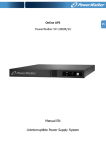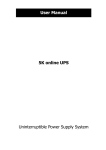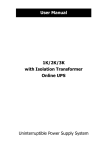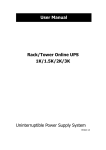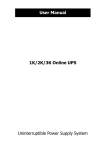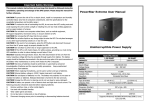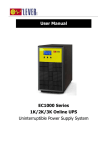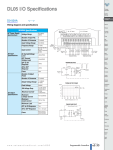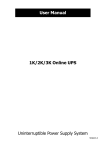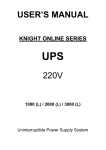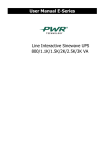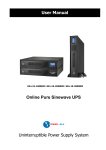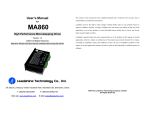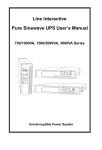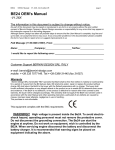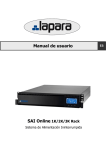Download User`s Manual - Voltronic Power
Transcript
User Manual 1U ONLINE UPS Uninterruptible Power Supply System Version: 1.6 Table of Contents 1. Important Safety Warning ....................................................................................................... 1 1-1. Transportation ................................................................................................................ 1 1-2. Preparation ..................................................................................................................... 1 1-3. Installation ..................................................................................................................... 1 1-4. Operation ........................................................................................................................ 1 1-5. Maintenance, service and faults..................................................................................... 1 2. Installation and setup . ............................................................................................................ 3 2-1. Rear panel view .............................................................................................................. 3 2-2. Setup the UPS ................................................................................................................. 3 3. Operations ................................................................................................................................ 6 3-1. Button operation ............................................................................................................ 6 3-2. LED Panel ........................................................................................................................ 6 4. Troubleshooting ....................................................................................................................... 8 5. Storage and Maintenance ........................................................................................................ 9 6. Specifications ......................................................................................................................... 10 1. Important Safety Warning Please comply with all warnings and operating instructions in this manual strictly. Save this manual properly and read carefully the following instructions before installing the unit. Do not operate this unit before reading through all safety information and operating instructions carefully. 1-1. Transportation • Please transport the UPS system only in the original package to protect against shock and impact. 1-2. Preparation • Condensation may occur if the UPS system is moved directly from cold to warm environment. The UPS system must be absolutely dry before being installed. Please allow at least two hours for the UPS system to acclimate the environment. • Do not install the UPS system near water or in moist environments. • Do not install the UPS system where it would be exposed to direct sunlight or near heater. • Do not block ventilation holes in the UPS housing. 1-3. Installation • Do not connect appliances or devices which would overload the UPS system (e.g. laser printers) to the UPS output sockets. • Place cables in such a way that no one can step on or trip over them. • Do not connect domestic appliances such as hair dryers to UPS output sockets. • The UPS can be operated by any individuals with no previous experience. • Connect the UPS system only to an earthed shockproof outlet which must be easily accessible and close to the UPS system. • When installing the equipment, it should ensure that the sum of the leakage current of the UPS and the connected devices does not exceed 3.5mA. 1-4. Operation • Do not disconnect the mains cable on the UPS system or the building wiring outlet (shockproof socket outlet) during operations since this would cancel the protective earthing of the UPS system and of all connected loads. • The UPS system features its own internal current source (batteries). The UPS output sockets or output terminals block may be electrically live even if the UPS system is not connected to the building wiring outlet. • Prevent no fluids or other foreign objects from inside of the UPS system. 1-5. Maintenance, service and faults • The UPS system operates with hazardous voltages. Repairs may be carried out only by qualified maintenance personnel. • Caution -risk of electric shock. Even after the unit is disconnected from the mains (building wiring outlet), components inside the UPS system are still connected to the battery and electrically live and dangerous. • Before carrying out any kind of service or maintenance, disconnect the batteries and verify that no current is present and no hazardous voltage exists in the terminals of high capability capacitor such as BUS-capacitors. 1 • • • • • • • • Only persons are adequately familiar with batteries and with the required precautionary measures may replace batteries and supervise operations. Unauthorized persons must be kept well away from the batteries. Caution -risk of electric shock. The battery circuit is not isolated from the input voltage. Hazardous voltages may occur between the battery terminals and the ground. Before touching, please verify that no voltage is present! Batteries may cause electric shock and have a high short-circuit current. Please take the precautionary measures specified below and any other measures necessary when working with batteries: -remove wristwatches, rings and other metal objects -use only tools with insulated grips and handles. When changing batteries, install the same number and same type of batteries. Do not attempt to dispose of batteries by burning them. This could cause battery explosion. Do not open or destroy batteries. Escaping electrolyte can cause injury to the skin and eyes. It may be toxic. Please replace the fuse only with the same type and amperage in order to avoid fire hazards. Do not dismantle the UPS system. 2 2. Installation and setup NOTE: Before installation, please inspect the unit. Be sure that nothing inside the package is damaged. Please keep the original package in a safe place for future use. 2-1. Rear panel view 1K 1KL 1 2 3 4 5 6 7 8 AC input Output receptacle: connect to mission-critical loads. Programmable outlets: connect to non-critical loads USB/RS-232 serial communication port ROO/RPO function connector SNMP intelligent slot Dry contact External battery connector 2-2. Setup the UPS Step 1: UPS input connection Plug the UPS into a two-pole, three-wire, grounded receptacle only. Avoid using extension cords. The power cord is attached to the UPS. The input plug is a NEMA 5-15P. Step 2: UPS output connection There are two kinds of output receptacles: programmable outlets and general outlet. Please 3 connect non-critical devices to the programmable outlets and critical devices to the general outlets. During power failure, you may extend the backup time to critical devices by setting shorter backup time for non-critical devices. Step 3: Communication connection Communication port: USB port RS-232 port Dry contact Intelligent slot To allow for unattended UPS shutdown/start-up and status monitoring, connect the communication cable one end to the USB/RS-232 port and the other to the communication port of your PC. With the monitoring software installed, you can schedule UPS shutdown/start-up and monitor UPS status through PC. The pin assignment for dry contact is listed Condition Yes Low battery. Pin 3 and Pin 9 are Output is abnormal. Pin 7 and Pin 8 are Battery mode. Pin 2 and Pin 6 are as below: Pin status connected. connected. connected. No Pin 3 and Pin 1 are connected. Pin 7 and Pin 5 are connected. Pin 2 and Pin 4 are connected. The UPS is equipped with intelligent slot perfect for SNMP card. When installing with SNMP card in the UPS, it will provide advanced communication and monitoring options. Step 4: Disable/Enable ROO/RPO function Contact open: UPS shuts down. Contact closed: UPS start-up (UPS is connected to AC power and AC power is available). Note: The local ON/OFF control by pressing On/Off button overrides the remote-control function. Contact open: UPS shuts down and Fault LED (3) will be ON. To return to normal operation, de-activate external remote contact (Fault LED (3) will be OFF) and restart the UPS by pressing button. Step 5: Turn on/off the UPS Press the ON/OFF button on the front panel for two seconds to power on the UPS. 4 Step 6: Install software For optimal computer system protection, install UPS monitoring software to fully configure UPS shutdown. You may insert provided CD into CD-ROM to install the monitoring software. If not, please follow steps below to download and install monitoring software from the internet: 1. Go to the website http://www.power-software-download.com 2. Click ViewPower software icon and then choose your required OS to download the software. 3. Follow the on-screen instructions to install the software. 4. When your computer restarts, the monitoring software will appear as an orange plug icon located in the system tray, near the clock. 5 3. Operations 3-1. Button operation 1K View: Button On/Off button Function • ON/OFF Button LED indicators • Turn on the UPS: Press and hold button for at least 2 seconds to turn on the UPS. Turn off the UPS: Press and hold this button at least 2 seconds to turn off the UPS. UPS will be in standby mode when utility power is normal or transfer to bypass mode if bypass mode is enabled via software. 1KL View: Button ON/Mute Button OFF/Enter Button Function Turn on the UPS: Press and hold ON/Mute button for at least 2 seconds to turn on the UPS. Mute the alarm: When the UPS is on battery mode, press and hold this button for at least 5 seconds to disable or enable the alarm system. But it’s not applied to the situations when warnings or errors occur. Turn off the UPS: Press and hold this button at least 2 seconds to turn off the UPS in battery mode. UPS will be in standby mode under power normal or transfer to Bypass mode if the Bypass enable setting by pressing this button. 3-2. LED Indicators 1K View: 6 UPS Status Line Mode Battery Mode Low battery Battery replacement Fault On/off status of output receptacles LED LED1 LED4 to LED7 indicate load level during line mode. LED4: > 75% load level LED5: 50% ~ 75% load level LED6: 25% ~ 50% load level LED7: 0% ~25% load level LED2 LED4 to LED7 indicate battery capacity during battery mode. LED4: battery voltage > 26V LED5: battery voltage > 24.5V LED6: battery voltage > 23V LED7: battery voltage > 21V LED7 LED3 LED3 LED 8: indicating on/off status of general output receptacles () LED 9: indicating on/off status of programmable outlet () Color Green Lighting/Flashing Lighting Green Lighting Yellow Flashing Green Lighting Green Red Red Green Flashing Flashing Lighting Lighting 1KL View: Three indicators to display UPS status: UPS Status Indicators AC Mode Green LED lighting. Battery Mode Yellow LED flashing. Fault Red LED lighting. Off-mode charging. Green LED flashing. 3-3. Audible Alarm Battery Mode Low Battery Overload Fault Bypass Mode Sounding every 4 seconds Sounding every second Sounding twice every second Continuously sounding Sounding every 10 seconds 7 4. Troubleshooting If the UPS system does not operate correctly, please solve the problem by using the table below. Symptom Possible cause Remedy No indication and alarm even The AC input power is not Check if input power cord though the mains is normal. connected well. firmly connected to the mains. The AC input is connected Plug AC input power cord to the UPS output. to AC input correctly. The mains is normal but red LED is flashing. The alarm is sounding every second. The alarm is sounding twice every second and red LED is flashing. The internal or external battery connection is wrong. UPS is overload Red LED is on and alarm is sounding continuously. UPS fault. Please re-connect battery wires with correct polarity. Remove excess loads from UPS output. Remove excess loads from UPS output first. Then, shut down the UPS and restart it. After repetitive overloads, the UPS is locked in the Bypass mode. Connected devices are fed directly by the mains. The mains is normal. But the unit Battery is not fully charged. Please charge battery at is on battery mode. least 5 hours. If battery is still in low battery level, please contact local dealer. Battery defect. Replace the battery with the same type of battery. Please contact local dealer directly. 8 5. Storage and Maintenance Operation The UPS system contains no user-serviceable parts. If the battery service life (3~5 years at 25°C ambient temperature) has been exceeded, the batteries must be replaced. In this case, please contact your dealer. Storage Before storing, charge the UPS 5 hours. Store the UPS covered and upright in a cool, dry location. During storage, recharge the battery in accordance with the following table: Model Storage Temperature Recharge Frequency Charging Duration 1K 1KL -25°C -50°C Every 3 months 1-2 hours 50°C -55°C Every 2 months 1-2 hours -25°C -40°C Every 3 months 1-2 hours 40°C -45°C Every 2 months 1-2 hours 9 6. Specifications MODEL CAPACITY INPUT Low Line Transfer Voltage Range Low Line Comeback High Line Transfer High Line Comeback Frequency Range Phase Power Factor OUTPUT Output voltage AC Voltage Regulation Frequency Range (Synchronized Range) Frequency Range (Bat. Mode) Overload Current Crest Ratio Harmonic Distortion Transfer AC Mode to Bat Mode Time Inverter to Bypass Waveform (Bat Mode) EFFICIENCY AC Mode Battery Mode BATTERY Battery Type Numbers Recharge Time PHYSICAL Dimension, D X W X H (mm) Net Weight (kg) ENVIRONMENT Operation Humidity 1K 1KL* 1000 VA / 800 W 80VAC/70VAC/60VAC/55VAC ± 5 % or 160VAC/140VAC/120VAC/110VAC ± 5 % ( based on load percentage 100% -80 % / 80 % -70 % / 70 -60 % / 60 % -0) 85VAC/75VAC/65VAC/60VAC ± 5 % or 170VAC/150VAC/130VAC/120VAC ± 5 % ( based on load percentage 100% -80 % / 80 % -70 % / 70 -60 % / 60 % -0) 150 VAC ± 5 % or 300 VAC ± 5 % 140 VAC ± 5 % or 290 VAC ± 5 % 40Hz ~ 70 Hz Single phase with ground ≧0.99 @ Nominal voltage (full load) 110/120 VAC or 220/230/240 VAC ± 1% 57 ~ 63 Hz or 47 ~ 53 Hz 60Hz or 50 Hz± 0.3 Hz 100%~105%: audible warning 105%-130%: UPS shuts down in 10 seconds at battery mode or transfers to bypass mode after 2min when the utility is normal. >130%: UPS shuts down immediately at battery mode or transfer to bypass mode after 10s when the utility is normal. 5:1 for 110/120 VAC system or 3:1 for 220/230/240 VAC systems ≦3 % THD (Linear Load) ≦ 5 % THD (Non-linear Load) Zero 4 ms (Typical) Pure Sinewave ~ 86% @ 100% load ~ 83% @ 100% load 6 V / 9 AH 4 9 hours recover to 90% capacity Lithium-iron battery or Sealed Lead-acid battery (Battery voltage: 48VDC) 477 x 438 x 44 12.6 300 x 438 x 44 6 20-90 % RH @ 0-50°C 20-90 % RH @ 0-40°C (non-condensing) (non-condensing) Less than 50dBA @ 1 Meter Noise Level MANAGEMENT USB/RS-232 Supports Windows® 2000/2003/XP/Vista/2008/7/8, Linux, Unix and MAC Optional SNMP Power management from SNMP manager and web browser *1KL is only available in 220/230/240VAC system. 10












